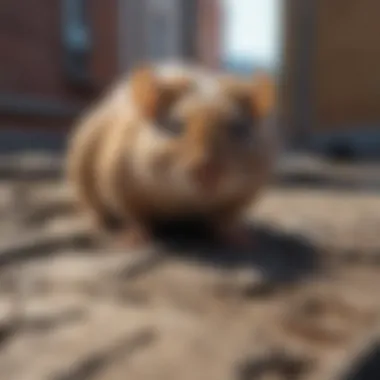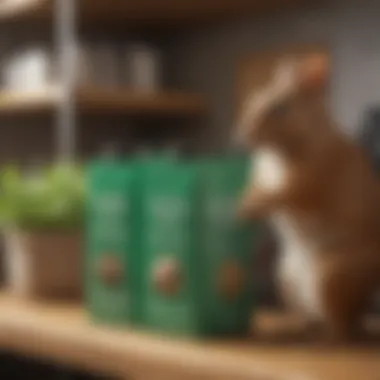Understanding Large Rodents in Residential Spaces


Intro
The presence of large rodents, especially rats, in residential spaces is not just an inconvenience; it is a serious concern that affects health and property. To understand the implications of these infestations, it is crucial to explore their characteristics, behaviors, and the environments they thrive in. This article aims to provide a comprehensive overview of the threats posed by large rodents, effective prevention techniques, and eco-friendly pest control solutions.
Understanding Pests
Definition of Pests
Pests refer to unwanted organisms that interfere with human activities, typically causing property damage or health issues. In this context, large rodents, particularly rats, fall under this category as they invade homes to seek food, shelter, and warmth. Their ability to reproduce quickly exacerbates the problem, making their management essential.
Importance of Pest Identification
Identifying the specific type of rodent is vital in managing an infestation. Different species exhibit distinct behaviors and habitats, which influence the effectiveness of control methods. For instance, the Norway rat prefers burrowing in soil or structural crevices, while the roof rat is more adept at climbing and often nests in trees or attics. Proper identification ensures that the chosen strategies align with the pest’s behavior, leading to a higher success rate in control efforts.
Prevention Techniques
Home and Garden Preventative Measures
Preventing large rodents from entering residential spaces requires vigilance and proactive measures. Here are effective strategies:
- Seal Entry Points: Inspect the exterior of the home for any gaps or holes. Seal these using materials such as steel wool or caulk.
- Manage Landscaping: Keep the garden tidy. Trim overgrown plants and maintain grass to reduce hiding spots.
- Secure Food Sources: Store food in airtight containers, and clean up promptly after meals to minimize attractants.
Seasonal Prevention Tips
Rodents often seek shelter during colder months. Adapting to seasonal changes can help in prevention:
- Autumn: Clear falling leaves and any debris that may accumulate.
- Winter: Ensure that attics and basements are insulated and monitored for any signs of rodent activity.
Eco-Friendly Pest Control Solutions
Overview of Sustainable Practices
Eco-friendly practices focus on minimizing harm to the environment while managing infestations. These methods prioritize natural over chemical solutions, adhering to sustainable practices that can be safely implemented in residential settings.
Natural Remedies and Their Effectiveness
Natural remedies can offer viable alternatives to traditional pesticides. Some effective options include:
- Peppermint Oil: The scent is known to deter rodents. Place cotton balls soaked in peppermint oil in key areas.
- Ultrasonic Repellents: These devices emit high-frequency sounds that interfere with rodent communication and mobility.
"Understanding the behavior and habits of large rodents is crucial in preventing infestations and protecting health."
In summary, understanding the presence of large rodents in residential environments is essential for maintaining a healthy living space. By identifying pest types, utilizing prevention techniques, and opting for eco-friendly solutions, homeowners can significantly reduce the risk and impact of infestations. This guides them towards a pest-free environment without compromising safety or well-being.
Prelims to Rodent Infestation
The topic of rodent infestation is quite important for homeowners. Understanding the effects that large rodents, especially rats, can have on residential spaces is essential for maintaining health and safety. Once rats establish themselves in a home, they can lead to various problems, including structural damage and health risks. This article aims to guide readers through the complexities of identifying rodent infestations and offers practical solutions for prevention and management.
Defining Rodent Infestations
Rodent infestations refer to the presence of rodents in the human living environment, particularly those that breed and multiply within close proximity to households. Large rodents, especially rats, can be viewed as a significant concern. These creatures are not just nuisances; they can also invade food supplies and cause damages.
Key characteristics of rodent infestations include the following:
- Signs of rodent activity: Such as droppings, gnawed materials, and noise at night.
- Environmental factors: Certain conditions can promote rodent habitation, like clutter and food waste.
- Reproduction: A few rodents can quickly multiply into a larger population, thus worsening the infestation.
"Rodent infestations reflect more than just the presence of animals; they indicate underlying issues in household management and environmental conditions."
Understanding rodent infestations facilitates better preparedness and response from homeowners. Equipting oneself with knowledge about the signs and implications of rodent problems can lead to timely interventions and effective management strategies.


Identifying the Big Rat Problem
Understanding how to identify the presence of large rodents, specifically rats, is crucial for homeowners. The significance of recognizing early signs cannot be overstated. An unchecked rat infestation can lead to severe health risks and considerable damage to the property.
Physical Characteristics of Large Rats
Large rats, such as the Norway rat and the roof rat, exhibit notable physical traits that can help in identification.
- Size: Norway rats can reach lengths of up to 16 inches, including their tails, while roof rats typically measure between 12 and 18 inches. Both species display a robust body structure.
- Color: Norway rats usually have brown or gray fur, whereas roof rats are often darker, presenting a black or dark brown coat.
- Eyes and Ears: Roof rats are distinguished by their large, prominent eyes and ears in comparison to their head size. On the other hand, Norway rats possess smaller ears relative to their bulkier heads.
- Tail: The tail of a roof rat is usually longer than its body, while a Norway rat has a shorter and thicker tail.
Identifying these features can aid homeowners in quickly recognizing potential infestations and responding appropriately.
Common Locations of Infestations
Rats tend to favor specific places in and around residential properties. Being aware of these can assist in earlier detection. Common locations include:
- Basements and Crawl Spaces: These dark, warm spaces often provide shelter and are less frequented by humans, making them ideal for rats.
- Attics: Roof rats, in particular, prefer elevated spaces. Holes or gaps around vents can serve as entry points.
- Kitchens: Food sources attract rats, and kitchens often provide easy access to crumbs and open containers.
- Garages: Cluttered garages may offer both shelter and food, making it a likely spot for infestation.
- Outdoor Areas: Overgrown vegetation or items stored close to the house can also provide cover for rats.
Regular inspection of these areas can prevent significant infestations or damage.
Recognizing these physical traits and common locations amplifies the chance of early detection. Homeowners who stay vigilant can take necessary steps to mitigate risks and maintain a safe living space.
The Health Risks Associated with Rats
The presence of large rodents, particularly rats, in residential spaces raises serious health concerns. Understanding the health risks associated with these infestations is crucial for homeowners aiming to protect their families and maintain a safe living environment. Rats are not just a nuisance; they are carriers of various diseases. These diseases can have significant implications for human health, particularly in homes where sanitation practices may be compromised. Ensuring awareness of these risks enables homeowners to take preventive steps before infestations escalate, thereby safeguarding their health.
Zoonotic Diseases Linked to Rat Infestations
Rats are known to carry numerous zoonotic diseases, meaning they can be transmitted from animals to humans. Among the most noteworthy is leptospirosis. This bacterial infection can lead to severe health complications if left untreated. It is often contracted through contact with contaminated water or soil where rat urine has been present. Another significant disease is hantavirus pulmonary syndrome, which is linked to contact with rat droppings and saliva. Symptoms can include severe respiratory distress.
Bacterial diseases like salmonellosis can also arise, typically through food contamination. Rodents can easily invade food supplies, leading to outbreaks of illness among residents. Here are some common diseases associated with rat infestations:
- Leptospirosis
- Hantavirus pulmonary syndrome
- Salmonellosis
- Lymphocytic choriomeningitis (LCMV)
Each of these diseases requires prompt medical attention, which can result in increased healthcare costs and potential loss of productivity.
Potential Allergies and Respiratory Issues
Allergies associated with rats are less discussed but equally important. Rat droppings, urine, and dander can trigger allergic reactions in sensitive individuals. Exposure can lead to symptoms such as sneezing, nasal congestion, or skin rashes.
Moreover, their droppings and body parts may contribute to airborne particles that can cause respiratory problems. People with asthma or other chronic conditions may find their symptoms exacerbated when in close proximity to rat infestations. Health effects can range from mild allergic reactions to severe respiratory conditions, necessitating immediate attention.
"The potential health risks from rat infestations extend beyond the realm of mere inconvenience; they can have profound implications for the health of inhabitants in affected homes."
Awareness of these health risks should motivate homeowners to monitor their living environments closely. Early detection and adoption of preventive measures can reduce the fast-spreading impact of rodent infestations and their accompanying health concerns.
Factors Contributing to Rat Infestations
Understanding the factors contributing to rat infestations is essential for maintaining a healthy living environment. If homeowners are aware of the elements that lead to an increase in rodent activity, they can implement preventive measures to safeguard their homes. This section discusses the environmental conditions, food sources, and structural vulnerabilities that allow rats to thrive in residential spaces.
Environmental Conditions Favoring Rats
Rats are highly adaptable creatures, able to survive in various climates and environments. However, certain environmental conditions can significantly increase the likelihood of infestation. For instance, an area with a high population of greenery can provide shelter and nesting materials for rats. Also, proximity to stagnant water sources can attract them. Their natural behavior includes scavenging, making them thrive in regions with easy access to potential nesting sites.
- Weather conditions: Warmer months often see increased rodent activity as they search for food and breeding sites.
- Urban settings: Densely populated areas provide food and shelter, creating a favorable environment for these pests.
- Neglected yards: Overgrown gardens or unkempt lawns can serve as hiding spots for rats, allowing them to breed and flourish unnoticed.
Addressing these environmental factors can significantly reduce the attractiveness of a property for rats and discourage their presence.
Food Sources That Attract Rodents


Another critical aspect of rat infestations relates to the availability of food sources. Rats will leave their nests in search of food, and if your home provides a reliable food source, it will quickly become a target. Common food sources include:
- Unsealed garbage: Rats are drawn to accessible rubbish like leftover food and scraps. Properly securing trash containers is vital.
- Pet food: Leaving pet food outside or unsealed can attract rodents. It is advisable to store pet food in airtight containers.
- Garden fruits or vegetables: Fruits fallen to the ground can also be a lure for rats. Regular garden maintenance helps mitigate this issue.
Implementing proper food storage practices and ensuring food is not easily accessible will help deter rats from invading your home.
Structural Vulnerabilities in Homes
Often, the design and maintenance of a house can either mitigate or exacerbate rat infestations. Identifying and addressing structural vulnerabilities is crucial for prevention. Key points to consider include:
- Cracks and holes: Even tiny openings can serve as entry points. Rats can squeeze through gaps the size of a quarter, so inspecting walls and foundations regularly is important.
- Doors and windows: Ensure doors and windows fit properly and are kept closed. Damaged screens can offer pathways for entry.
- Basements and attics: These areas are common access points for rodents. It’s vital to keep them clean and check for signs of entry.
Preventive strategies should focus on sealing potential entry points and maintaining overall structural integrity.
Quote: "Rats are highly resourceful and opportunistic. They take advantage of every small opportunity that humans provide."
By addressing these factors contributing to rat infestations, homeowners can take informed steps to minimize the risk of rodent activity in their living spaces. This comprehensive understanding not only helps in identification but also spurs effective mitigation tactics.
Preventive Measures for Homeowners
Preventing large rodents from invading residential spaces is critical for maintaining a healthy home environment. Homeowners need to approach prevention with diligence. The focus should be on creating barriers that deter rats, recognizing the shared spaces in which they thrive. Understanding the methods of prevention is beneficial not only for safeguarding one’s property but also for ensuring the health of the family, as rodent infestations can lead to various health risks and structural damage to homes.
Monitoring and Identifying Entry Points
Identifying entry points is a crucial step in preventing rodent infestations. Rats are adept at finding ways into homes, often using small openings, cracks, or gaps around pipes, windows, and doors. Homeowners should conduct regular inspections to locate these points. Here are some effective strategies:
- Visual Inspection: Examine the exterior of the house. Look for any holes or fissures that are bigger than a quarter. Pay attention to the foundations, roofing, and areas where utilities enter the home.
- Seal Vulnerabilities: Use materials like steel wool, caulk, or expanding foam to seal identified gaps. These materials are not easy for rodents to gnaw through.
- Monitoring Tools: Set up motion-activated cameras or traps to capture any signs of rodents at potential entry points. This can help determine if there is an active threat.
By monitoring and sealing entry points, homeowners can drastically reduce the likelihood of rat infestations.
Implementing Effective Waste Management Practices
Waste management plays a significant role in rodent prevention. Rats are attracted to food sources that are easily accessible. Therefore, homeowners should adopt stringent waste management practices. Some practical tips include:
- Proper Disposal: Use heavy-duty trash cans with tight-fitting lids to reduce access. Dispose of waste regularly and avoid leaving trash bags outside overnight.
- Composting: If composting organic waste, ensure that the bin is rodent-proof. This involves using a container with a secure lid and a base that prevents burrowing.
- Outdoor Food Sources: If feeding pets outdoors, remove any leftover food promptly. Bird feeders should also be maintained to not allow seeds to fall and attract rodents.
These practices can significantly minimize the allure of food sources for large rodents.
Regular Maintenance and Repairs
Regular maintenance and repairs are fundamental to preventing rodent infestations. Homeowners should view the upkeep of their property as a continuous obligation. Key considerations include:
- Routine Check-ups: Schedule periodic inspections of both the interior and exterior of the home. Look for gnaw marks, droppings, or nests, which indicate potential infestations.
- Repairing Damage: Fixing holes or damaged areas in the home’s structure promptly can prevent rodents from making their way inside. This includes repairing screens and ensuring that all vent openings have protective mesh.
- Landscaping Maintenance: Keep bushes and trees trimmed and away from the house. This lessens the likelihood of rodents finding a pathway to the home.
Ecological Roles of Rodents
Understanding the ecological roles of rodents is crucial for several reasons. Large rodents, particularly rats, are often seen through a negative lens due to their association with residential infestation. However, they play significant roles in the ecosystem that can sometimes be overlooked. This section discusses some of these roles, highlighting their benefits, the balance they maintain within nature, and considerations for their management in residential areas.
Rodents contribute to various ecological processes. They are a part of the food chain, serving as prey for a diverse range of wildlife. Birds of prey, snakes, and even some mammals rely on rodents for sustenance. The presence of healthy rodent populations can indicate a balanced ecosystem and a thriving food web.
These creatures also aid in seed dispersal and the germination of plants. For instance, when rodents store seeds for later consumption, some may be forgotten, leading to the growth of new plants. This unintentional planting assists in maintaining plant diversity and ecosystem health.
Additionally, rodents contribute to soil aeration. Their burrowing activities help to loosen the soil, allowing for better air and water penetration. This can improve the overall health of the soil, leading to more robust vegetation regardless of whether they are in wild or altered environments.
Rodents can act as a barometer for ecological health. When their populations fluctuate, it may indicate changes in habitat health or food availability, sending signals to those observing the environment.
However, when considering the ecological roles of rodents, it is essential to weigh the benefits against the potential challenges they pose in residential spaces. Large rodents, particularly when they thrive near human habitats, can lead to significant health risks and property damage. This duality prompts an important discussion about management techniques that can address both ecological balance and human safety.
In summary, rodents play a vital role in ecosystems. Their contributions to food webs, plant dispersal, and soil health cannot be ignored. Nonetheless, their proximity to human habitats requires careful oversight to mitigate adverse effects, ensuring that their ecological services do not conflict with human safety and comfort.


Management Techniques for Rat Infestations
Managing rat infestations is critical for homeowners who wish to protect their health and property. Large rodents, if left unchecked, not only create unsanitary conditions but can also cause substantial structural damage to homes. Understanding various management techniques empowers homeowners to tackle the problem effectively. It is essential to recognize the balance between addressing an ongoing issue and preventing future infestations.
Trap Types and Their Effectiveness
Traps serve as a popular method for directly reducing rat populations. There are several traps available, each designed to address specific needs. Snap traps are one of the oldest types, which provide a quick, humane solution by killing the rodent instantly. These traps are simple to set and can be placed in areas where rat activity is observed, such as along walls or near known entry points. However, they may require regular monitoring to ensure their effectiveness.
Other options include electronic traps, which kill rats using a high-voltage shock. These devices are less messy than snap traps and allow for easy disposal of carcasses. Bait stations are also effective, containing bait that attracts rats to a sealed environment where they can die without posing threats to pets or children.
In summary, selecting the right type of trap depends on personal preference and the specific circumstances of the infestation. Homeowners are encouraged to assess their living spaces and determine the most suitable traps to use, bearing in mind the potential for ongoing maintenance.
Chemical Control Strategies
Chemical control strategies can also be employed to manage rat populations. The most common method involves the use of rodenticides, which are toxic substances designed to kill rodents. These chemicals can be effective but must be approached with caution. Different types of rodenticides operate in various ways; some cause internal bleeding, while others affect the nervous system.
One main consideration when using chemical solutions is the potential risk to non-target animals, including pets and even local wildlife. Proper placement of these chemicals is necessary to minimize unintended casualties. Homeowners should consider consulting with pest control professionals for assistance in selecting and safely applying rodenticides.
Additionally, it is crucial to stay informed about local laws regarding the use of rodenticides, as regulations can vary widely. While chemicals may provide immediate results, a strategic approach often yields better long-term management outcomes.
Integrated Pest Management Approaches
Integrated Pest Management, or IPM, is a comprehensive approach to managing rat infestations that focuses on prevention, monitoring, and control. This strategy emphasizes the importance of understanding the environment and the habits of rats to reduce the likelihood of infestations occurring in the first place.
Key components of an IPM program include:
- Inspection: Regularly inspecting the home for signs of rat activity can help identify problems before they escalate.
- Sanitation: Maintaining cleanliness around the home eliminates potential food sources for rats.
- Exclusion: Sealing gaps and cracks in the home prevents rodents from entering. Simple materials like steel wool can be effective in blocking entry points.
- Monitoring: Keeping track of rodent sightings or trap captures helps gauge the effectiveness of the control measures.
By utilizing IPM, homeowners can minimize reliance on pesticides, focusing instead on a holistic approach to pest management. This method promotes a sustainable environment while ensuring a safe living space for residents.
"The key to effective rat management lies not just in removal but in prevention, creating an inhospitable environment for rats."
When to Call Professionals
Recognizing when to seek help from pest control professionals is crucial for homeowners dealing with large rodent infestations. A timely response can prevent further damage to your home and reduce health risks. Understanding the signs of a serious infestation enables homeowners to act before the problem escalates. Experts not only bring experience but also effective tools and methods that are often unavailable to the average homeowner.
Indicators of a Serious Infestation
To determine if a rodent issue requires professional intervention, several key indicators should be observed:
- Frequent Sightings: Observing multiple rats, especially during the day, is a red flag. Regular sightings can indicate a burgeoning colony.
- Excessive Droppings: Rat droppings are typically about the size of a rice grain and found in accumulations. A sudden increase in droppings can illustrate a significant problem.
- Gnaw Marks: Look for gnawed furniture, baseboards, or cords. Rats will chew on various materials, which can lead to structural integrity issues and fire hazards.
- Nesting Material: Shredded paper, fabric, or insulation in hidden areas could suggest that rats are nesting nearby.
- Strong Odor: A musty smell can emanate from a infestations location, signaling the presence of rodents.
- Noise: Scratching, squeaking, or scurrying sounds during the night can indicate a larger population seeking shelter and food.
Overall, these indicators highlight the necessity for professional pest control services to address serious infestations effectively.
Evaluating Pest Control Services
Once the decision to call professionals has been made, evaluating which pest control service to engage is equally important. Homeowners should consider several factors when selecting a service:
- Reputation: Look for companies with positive reviews. Checking websites like Reddit and Facebook can provide insights from other customers.
- Experience: It's essential to choose a service that specializes in rodent control and has a proven history of successful eradication.
- Methods Used: Inquire about the strategies and products they employ. Eco-friendly options may be preferred by some homeowners.
- Guarantees: A policy that offers follow-up visits or re-treatment, if necessary, can provide peace of mind.
- Cost Estimates: Request detailed quotes. You should understand what you are paying for and any additional fees involved in the process.
By thoughtfully selecting a pest control service, homeowners can ensure that their rodent issues are resolved swiftly and efficiently.
The End
The presence of large rodents in residential areas is a significant concern. This article has examined why addressing this issue is vital for homeowners entangled in the fight against rat infestations. Knowing how to identify the existence of rats and the risks they pose is crucial for maintaining a safe living environment. Additionally, it is essential to understand how these creatures can impact health and property.
Effective prevention strategies have been emphasized throughout the text. Emphasizing the steps necessary to mitigate risks can empower homeowners. Simple actions, such as regular inspections and appropriate waste disposal, can have substantial impacts on keeping homes free from pests. Sustainability, paired with proactive management, offers a holistic approach to tackling infestations.
Moreover, this article has detailed situations when to seek professional help. Knowing the indicators of a serious infestation allows one to act swiftly before the problem worsens.
In summary, focusing on the aspects discussed, such as ecological impacts, safety, and practical measures, equips homeowners with the information required to combat rodent threats effectively. By understanding the dynamics at play, householders can not only protect their homes but also foster a healthier living space.
Summary of Key Points
- Rat infestations can pose serious health risks and structural issues.
- Identification of signs and behaviors related to rats is crucial for homes.
- Preventive measures include monitoring entry points and proper waste management.
- Knowing when to consult pest control services is important for effective management.
- Sustainable and integrated approaches can lead to long-lasting rodent control solutions.



